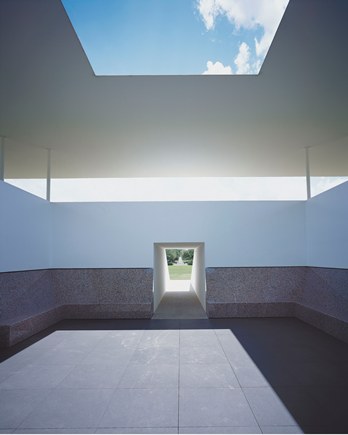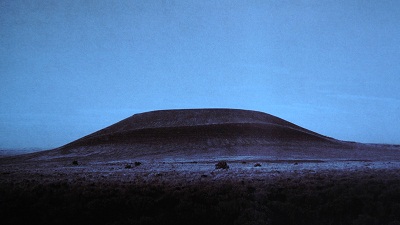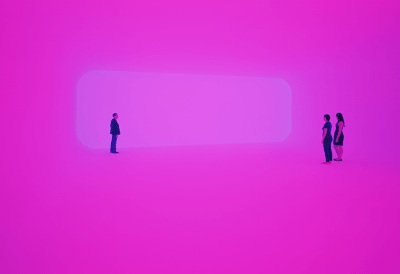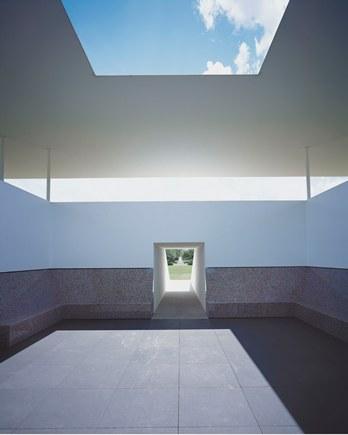Last month we shared thoughts from college students who have spent the summer conversing with visitors to James Turrell: A Retrospective. Here is part two of the conversation:
LACMA: In what ways has this exhibition changed how you have thought about art? Museums?
Evangelyn Delacare (recent graduate, UCLA): My first day was a unique experience that can only be attributed to Turrell’s unique work. Each interaction I had was different; I had been learning about Turrell and his work through scholarly text and articles. But now, I was meeting people who had met Turrell, people who had visited Roden Crater, people who had been following his career since the beginning. No matter the amount of texts and articles I could have possibly read, I could only get certain stories through the public, through the people who were fans of Turrell’s work, through those who have traveled around the nation visiting all three Turrell retrospectives happening at once.
 James Turrell, Twilight Epiphany, 2012, a James Turrell Skyspace, the Suzanne Deal Booth Centennial Pavilion, Rice University, Houston, Texas, © James Turrell, photo © Florian Holzherr
James Turrell, Twilight Epiphany, 2012, a James Turrell Skyspace, the Suzanne Deal Booth Centennial Pavilion, Rice University, Houston, Texas, © James Turrell, photo © Florian Holzherr
Kristen Laciste (senior, UCLA): This exhibition has made me reflect on the limits of the museum space, particularly the spaces dedicated to Roden Crater. Turrell’s magnum opus certainly could not be transported nor fit in the museum, so it made me think about the challenges the curators and educators face in communicating information about the work to the public. I interacted the most with visitors in the Resnick Pavilion in the Roden Crater room, and I was asked questions regarding its location, size, opening date, and relationship to Turrell’s other works.
 Erin Shirreff, Roden Crater, 2009, purchased with funds provided by Said Saffari and Heidi Wettenhall-Saffari through Contemporary Friends, 2012
Erin Shirreff, Roden Crater, 2009, purchased with funds provided by Said Saffari and Heidi Wettenhall-Saffari through Contemporary Friends, 2012
Aida Lugo (recent graduate, Otis College of Art and Design): The excitement surrounding the crater was incredible. Although it is not open to the public, the audience wanted to know how Turrell was excavating such a project. The model of the crater was just as interesting a conversation starter. The public wondered how it was created and how it represented the crater. I met a woman who visited the crater. She said she flew in with her family and was given a by Turrell. I told the public this story many times. I asked the woman if I could touch her, she was like a celebrity!
 James Turrell, Light Reignfall, 2011, Gaswork, courtesy of James Turrell, Pace Gallery, and Garage Center for Contemporary Culture, Moscow, installation view at Garage Center for Contempoaray Culture, 2011, © James Turrell, photo © Florian Holzherr
James Turrell, Light Reignfall, 2011, Gaswork, courtesy of James Turrell, Pace Gallery, and Garage Center for Contemporary Culture, Moscow, installation view at Garage Center for Contempoaray Culture, 2011, © James Turrell, photo © Florian Holzherr
Evangelyn: These conversations didn’t just end at Turrell’s work. Turrell’s work had a special quality about it that allowed an encompassing connection through all the people experiencing it, much like how the Ganzfeld encompassed everyone inside. The second a group would exit the Ganzfeld, and excited chatter would break out over the shared experience. Initially, we would be discussing Turrell’s work, but then move on to other matters of our lives. Talk about Turrell simply turned into talk about life. Turrell’s work can never neatly fit into a category of art; he used science, optics, astronomy, and so many other elements to create these artworks. It’s only natural that conversations would wander into other paths as well.
Marissa Clifford (senior, UCLA): My time at LACMA gave me hope for contemporary art; while we may have exhausted the possibilities of traditional media in the modern sense, the public’s enthused response to Turrell’s work revealed that we have not exhausted the possibilities for art as a whole. The answer it seems, lies in connections, pairings, collaborations; within the collaboration between traditional art and psychology in Turrell’s work, between the exterior physical world and our own interior metaphysical ones, within the collaboration between artists and museum spaces, between art and the public, between those who study the art and those who observe it lies the essence of Turrell’s oeuvre, LACMA’s commitment to accessible art, and dare I say, the future of art itself.
 James Turrell, Breathing Light, 2013, Los Angeles County Museum of Art, purchased with funds provided by Kayne Griffin Corcoran and the Kayne Foundation, © James Turrell, Photo © Florian Holzherr
James Turrell, Breathing Light, 2013, Los Angeles County Museum of Art, purchased with funds provided by Kayne Griffin Corcoran and the Kayne Foundation, © James Turrell, Photo © Florian Holzherr
LACMA: Has the exhibition and your time at LACMA impacted your own studies?
Marissa: After spending consecutive hours speaking with the public, Turrell’s concepts appeared universally intriguing and accessible. Throughout my time as a student educator at LACMA, I heard a variety of responses to his unusual work. As a student of art history, I am primarily interested in art (in the general sense) because I am interested in people. Engaging complete strangers in intellectual discussions about the nature of light and its role in shaping perception, reminded me that art is alive and evolving. Most people walked out from part one of the exhibition blinking their eyes and gently shaking their heads as they met the bright Los Angeles daylight.
Evangelyn: I'm so glad I was a part of this program; it really was a pleasure to go in every time and see Turrell's work and others' reactions.
Aida: I have always believed in art and its ability to educate, grow, empower and create communities and worlds, which is the reason I studied fine art and community art engagement in college. This internship showed me the true potential of ideas flourishing in a setting where it can be accessed by the public and used to entertain and amaze audiences. It made me so proud to be an artist and an educator. I wish to continue my education to be a museum educator, and a teaching artist.
Elizabeth Gerber, Education and Public Programs



